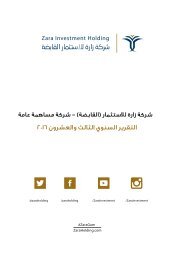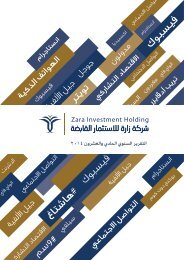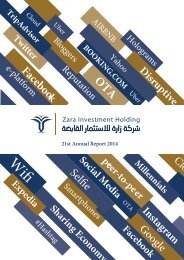ZaraAnnual-English2016
You also want an ePaper? Increase the reach of your titles
YUMPU automatically turns print PDFs into web optimized ePapers that Google loves.
liabilities of the subsidiary<br />
•Derecognizes the carrying amount of any non-controlling<br />
interests<br />
•Derecognizes the cumulative translation differences<br />
recorded in equity<br />
•Recognizes the fair value of the consideration received<br />
•Recognizes the fair value of any investment retained<br />
•Recognizes any surplus or deficit in profit or loss<br />
•Reclassifies the parent’s share of components previously<br />
recognized in OCI to profit or loss.<br />
The Company’s subsidiaries and its ownership percentages<br />
are disclosed in note (28).<br />
2.3 Changes in accounting policies<br />
The accounting policies used in the preparation of the<br />
consolidated financial statements are consistent with<br />
those used in the preparation of the consolidated financial<br />
statements for the year ended 31 December 2015 except<br />
for the followings:<br />
Equity Method in Separate Financial Statements<br />
(Amendments to IAS 27 and IFRS 1)<br />
In August 2014, the IASB amended IAS 27 Separate Financial<br />
Statements which restore the option for entities, in the<br />
separate financial statements, to account for investments in<br />
subsidiaries, associates and joint ventures using the equity<br />
method as described in IAS 28 Investments in Associates<br />
and Joint Ventures. A consequential amendment was<br />
also made to IFRS 1 First-time Adoption of International<br />
Financial Reporting Standards. The amendment to IFRS<br />
1 allows a first-time adopter accounting for investments<br />
in the separate financial statements using the equity<br />
method, to apply the IFRS 1 exemption for past business<br />
combinations to the acquisition of the investment.<br />
IAS 1 Presentation of Financial Statements –<br />
Amendments to IAS 1<br />
The amendments to IAS 1 include narrow-focus<br />
improvements related to:<br />
•Materiality<br />
•Disaggregation and subtotals<br />
•Notes structure<br />
•Disclosure of accounting policies<br />
•Presentation of items of other comprehensive income<br />
(OCI) arising from equity accounted investments<br />
Investment entities (Amendments to IFRS 10 and<br />
IAS 28)<br />
The amendments address the issues arising in practice in<br />
the application of the investment entities consolidation<br />
exception and clarify that:<br />
•The exemption from presenting consolidated financial<br />
statements applies to a parent entity that is a subsidiary<br />
of an investment entity, when the investment entity<br />
measures all of its subsidiaries at fair value.<br />
•Subsidiary that is not an investment entity itself and<br />
provides support services to the investment entity is<br />
consolidated. All other subsidiaries of an investment entity<br />
are measured at fair value.<br />
•Application of the equity method by a non-investment<br />
entity that has an interest in an associate or joint venture<br />
that is an investment entity: The amendments to IAS 28<br />
Investments in Associates and Joint Ventures allow the<br />
investor, when applying the equity method, to retain the<br />
fair value measurement applied by the investment entity<br />
associate or joint venture to its interests in subsidiaries.<br />
Amendments to IAS 16 and IAS 38: Clarification<br />
of Acceptable Methods of Depreciation and<br />
Amortization<br />
The amendments clarify the principle in IAS 16 and IAS 38<br />
that revenue reflects a pattern of economic benefits that<br />
are generated from operating a business (of which the<br />
asset is part) rather than the economic benefits that are<br />
consumed through use of the asset. As a result, a revenuebased<br />
method cannot be used to depreciate property,<br />
plant and equipment and may only be used in very limited<br />
circumstances to amortize intangible assets.<br />
Amendments to IFRS 11 Joint Arrangements:<br />
Accounting for Acquisitions of Interests<br />
The amendments to IFRS 11 require that a joint operator<br />
accounting for the acquisition of an interest in a joint<br />
operation, in which the activity of the joint operation<br />
constitutes a business, must apply the relevant IFRS 3<br />
principles for business combinations accounting. The<br />
amendments also clarify that a previously held interest in a<br />
joint operation is not remeasured on the acquisition of an<br />
additional interest in the same joint operation while joint<br />
control is retained. In addition, a scope exclusion has been<br />
added to IFRS 11 to specify that the amendments do not<br />
apply when the parties sharing joint control, including the<br />
reporting entity, are under common control of the same<br />
ultimate controlling party.<br />
The amendments apply to both the acquisition of the<br />
initial interest in a joint operation and the acquisition of<br />
any additional interests in the same joint operation.<br />
The implementation of the new amendments did not have<br />
impact on the Group’s financial position or performance<br />
and became effective for annual periods which started<br />
from 1 January 2016.<br />
2.4 Summary of Significant Accounting Policies<br />
Property and equipment<br />
Property and equipment is stated at cost, net of<br />
accumulated depreciation and/or accumulated<br />
impairment losses. Such cost includes the cost of replacing<br />
Annual Report 2016 67
















